#Bancroft Park
Photo
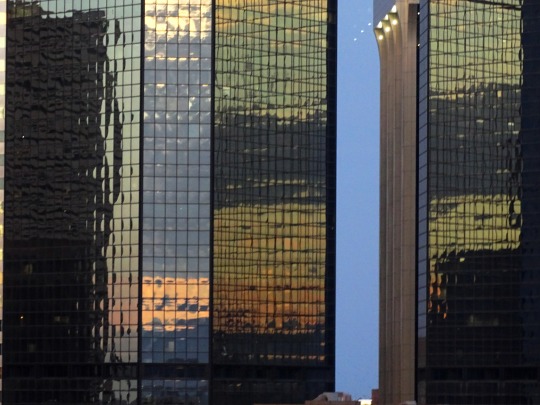

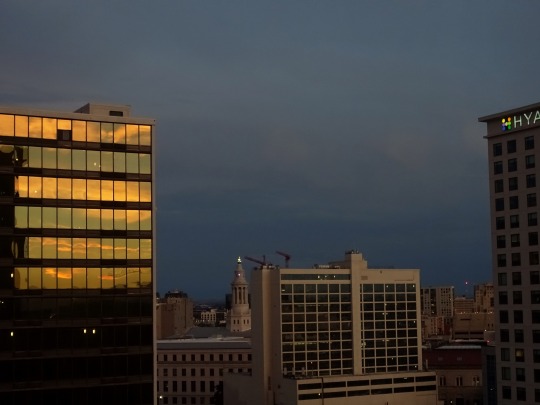


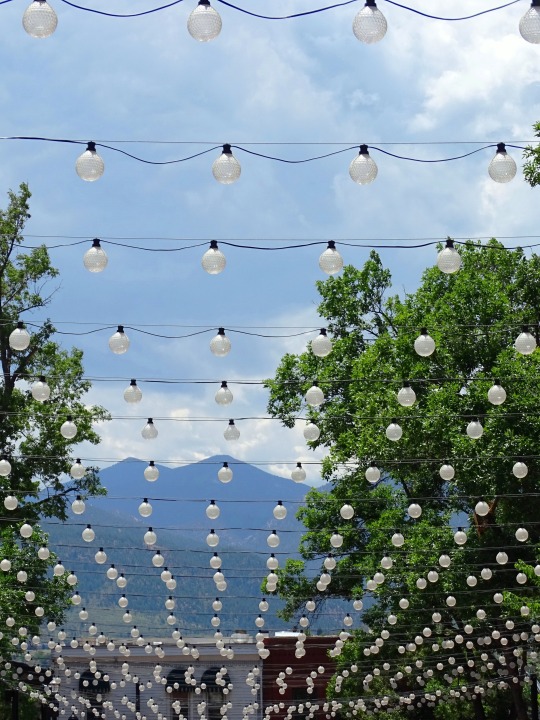
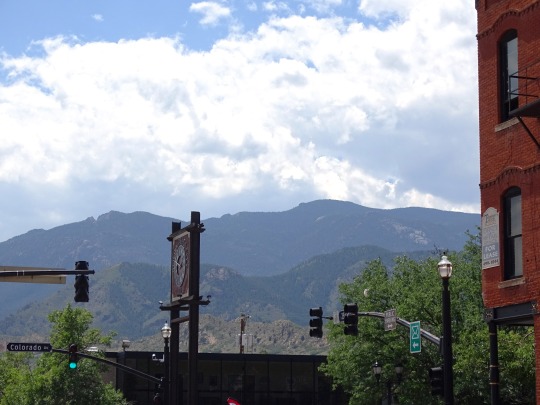


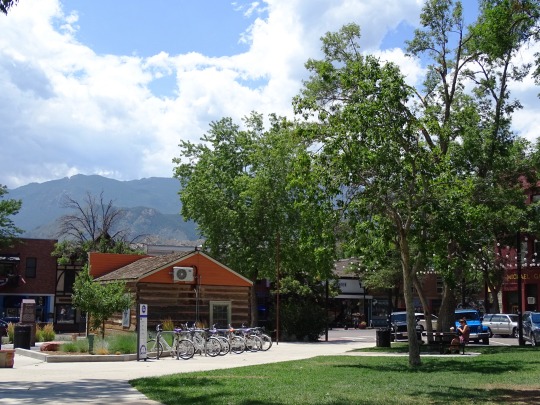
Clouds (No. 1009)
Denver, CO (five pics)
Old Colorado City (five pics)
#Denver#Mile High City#dusk#evening light#evening sky#daylight#travel#Colorado#Old Colorado City#Colorado Springs#architecture#cityscape#USA#Bancroft Park#Rocky Mountains#Mountain West Region#landmark#tourist attraction#blue sky#clouds#overcast#original photography#summer 2022#tree#nature#reflection#skyscraper#string of lights#vacation
6 notes
·
View notes
Text
It was an unusual protest, even by the standards of a city that has experienced hundreds of them over the decades.
A Leap Day demonstration this past Thursday at the shipping container wall around People’s Park in Berkeley continued a tradition of using leap year’s extra day for protest. But in addition to the usual banners, chants and music accompaniment from a small marching band, there were��� slingshots.
Organizers from the Slingshot Collective launched seed bombs — solid dirt balls filled with seeds — over the double-stacked shipping containers and into the now-former park using slingshots, both store bought and homemade.
“People go to a lot of boring protests, and this is an alternative and we are protesting real issues,” volunteer James Palmer said during the event. The Slingshot Collective has hosted a Leap Day protest every four years since 2000, according to Palmer.
The Leap Day protest began at the corner of Bancroft Way and Telegraph Avenue, with demonstrators marching to Chase bank to protest their climate policies and support for the “Cop City” development in Atlanta, Georgia, before making their way to the perimeter of what was formerly known as People’s Park.
“With the shipping containers, obviously we can’t push them over, we can’t get over them,” Palmer said. “We wanted to figure out a way to express our displeasure, not only at what’s happening, but at the ridiculous overreaction of building a wall like this.”
“We wanted to figure out a way to express our displeasure, not only at what’s happening, but at the ridiculous overreaction of building a wall like this.” James Palmer, protester
A recent Berkeleyside report that found UC Berkley spent upwards of $4.4 million dollars on security at the site, “…which is like a crazy overreaction to basically a small number of Berkeley hippies,” according to Palmer.
“We are the people who they’re worried about, the people that they’re trying to keep out, and we’re not dangerous,” Palmer said.
Protesters like Elisa Smith are hopeful that the community that centered around People’s Park will find a new home.
“The park, it’s all ages, all colors, all genders, all economic backgrounds, all together and that kind of breaking of bread that can happened in common space — it’s something magical at the park,” Smith said. “These days it’s like a real lucky thing to have a place where we’re all together, just all walks of life.”
Although the protest was peaceful, community members who did not appear to be present for the march to the location began spray painting shipping containers as the event came to a close. No arrests were made, but officers took photos and video of at least two adults and one child using spray paint on the containers.
14 notes
·
View notes
Text
@farina-bancroft
Oxford had lost track of the cannons and the fireworks. He had lost track of the faces in the sky and of the locations in the park. He had lost track of the last time he had eaten, of the last time he had water, and - most of all - the number of Tributes he had killed with the machete still clenched tight in his fist.
His leg was in rough shape. His foot had gone numb from the lack of shoes, or the snake's attack, or from something different altogether. He could feel the numbness working its way up his leg, but for now, it was still functional. And that was all he needed - to keep moving forward.
Sparks were flying through the air, briefly illuminating the otherwise dark night. Lamps flashed on and off, fires were building. And all Ox could do was move forward. A figure appeared ahead of him. He slowly raised his machete, but then he clocked who it was. "FARINA!" He roared, dropping the blade to his side and rushing forward.
"Farina, we have to move! The fire is -- the fire --" He indicated behind him, where hazards abounded. He pointed forward over her shoulder, where a roller coaster thundered along. "We gotta get to the queue!" An inclined ramp led up towards the coaster, where the flames wouldn't be able to reach them.
12 notes
·
View notes
Text
Does art make a difference?
Aw, sure. Of course there are degrees of extremity to the potential change that art can effect, depending on how many people are able to engage with it. The Beatles made a huge difference in the world. But Henry Darger, Jeff McKissack, Karen Dalton, Pauline Oliveros, Kenneth Patchen – there are so many folks who have made great art and not gotten massively famous for it, yet I think there are all sorts of ways their work informs and shapes other people’s work, and brains, and decisions.
Should politics and art mix?
Well, everything mixes, the New Statesman! That’s like asking if a knee-reflex hammer and a quadriceps tendon should “mix”.
Is your work for the many or for the few?
That’s for the many/few to say. I just crank out the hot jams.
If you were world leader, what would be your first law?
Gravity. I feel like we need to tighten up the constitutional protections that particular law enjoys. It’s a ticking time bomb, if you ask me.
Who would be your top advisers?
Cute angel on one shoulder, cute devil on the other.
What, if anything, would you censor?
Maybe we could all agree to not bust each other’s chops all cut-dang day.
If you had to banish one public figure, who would it be?
Don’t know, banishment might be a little extreme, but I’d sure like to take that Stephen Hawking dude down a notch or two. Right? Are you with me?
What are the rules that you live by?
Basically, “bros before hos”. I feel like if you stay true to that, everything else just kind of falls into place.
Do you love your country?
I love William Faulkner, Dolly Parton, fried chicken, Van Dyke Parks, the Grand Canyon, Topanga Canyon, bacon cheeseburgers with horseradish, Georgia O’Keeffe, Grand Ole Opry, Gary Snyder, Gilda Radner, Radio City Music Hall, Big Sur, Ponderosa pines, Southern BBQ, Highway One, Kris Kristofferson, National Arts Club in New York, Ruth Crawford Seeger, Joni Mitchell, Ernest Hemingway, Harriet Tubman, Hearst Castle, Ansel Adams, Kenneth Jay Lane, Yuba River, South Yuba River Citizens League, “Alice Doesn’t Live Here Anymore”, “Hired Hand”, “The Jerk”, “The Sting”, “Butch Cassidy and the Sundance Kid”, clambakes, lobster rolls, s’mores, camping in the Sierra Nevadas, land sailing in the Nevada desert, riding horseback in Canyon de Chelly; Walker Percy, Billie Holiday, Drag City, Chez Panisse/Alice Waters/slow food movement, David Crosby, Ralph Lauren,San Francisco Tape Music Center, Albert Brooks, Utah Phillips, Carol Moseley Braun, Bolinas CA, Ashland OR, Lawrence KS, Austin TX, Bainbridge Island WA, Marilyn Monroe, Mills College, Elizabeth Cotton, Carl Sandburg, the Orange Show in Houston, Toni Morrison, Texas Gladden, California College of Ayurvedic Medicine, Louis Comfort Tiffany, Saturday Night Live, Aaron Copland, Barack Obama, Oscar de la Renta, Alan Lomax, Joyce Carol Oates, Fred Neil, Henry Cowell, Barneys New York, Golden Gate Park, Musee Mechanique, Woody Guthrie, Maxfield Parrish, Malibu, Maui, Napa Valley, Terry Riley, drive-in movies, homemade blackberry ice cream from blackberries picked on my property, Lil Wayne, Walt Whitman, Halston, Lavender Ridge Grenache from Lodi CA, Tony Duquette, Julia Morgan, Lotta Crabtree, Empire Mine, North Columbia Schoolhouse, Disneyland, Nevada County Grandmothers for Peace; Roberta Flack, Randy Newman, Mark Helprin, Larry David, Prince; cooking on Thanksgiving; Shel Siverstein, Lee Hazlewood, Lee Radziwill, Jackie Onassis, E.B. White, William Carlos Williams, Jay Z, Ralph Stanley, Allen Ginsberg, Cesar Chavez, Harvey Milk, RFK, Rosa Parks, Arthur Miller, “The Simpsons”, Julia Child, Henry Miller, Arthur Ashe, Anne Bancroft, The Farm Midwifery Center in TN, Martha Graham, Alvin Ailey, Jr., Eleanor Roosevelt, Clark Gable, Harry Nilsson, Woodstock, and some other stuff. Buuuut, the ol’ U S of A can pull some pretty dick moves. I’m hoping it’ll all come out in the wash...
Are we all doomed?
If we keep our expectations pretty low I think we might be fine. I mean, we’re definitely all dying at some point. There’s no getting around that. But between now and then, things might start looking up!
— Joanna Newsom for The New Statesman, 2008
#joanna newsom#isn't she simultaneously just the most hilarious and thoughtful person?#i love her so much#a few people have asked me for that one quote about loving her country but the whole interview is a real gem i hope y'all enjoy it#love joanna#jnew
18 notes
·
View notes
Text

welcome to rainbow apartments, EVERYONE! before you grab your apartment keys and move in, review your tenant checklist and make sure everything gets followed. we can't wait to see you at the next mixer!
esther yu as leyla wang aka seafoam (apartment 406), penned by cherry
gracie abrams as presley "reese" bram aka dusty rose (apartment 402), penned by jules
davika hoorne as chalita sakdan aka maroon (apartment 603), penned by talia
felix lee as phoenix lee aka magenta (apartment 606), penned by jett
camila mendes as gabriela santos aka crimson (apartment 509), penned by cherry
roseanne park as serena yeo aka hot pink (apartment 403), penned by gia
jessie mei li as noa zhang aka sunflower (apartment 607), penned by jules
havana rose liu as ivy chen aka green (apartment 407), penned by ki
sabrina carpenter as natalia "lia" wilson aka mango (apartment 409), penned by caroline
avan jogia as ari patel aka lilac (apartment 503), penned by sun
ayo edebiri as fiona rockwell aka navy (apartment 407), penned by z
sydney sweeney as lola bancroft aka vermilion (apartment 506), penned by gia
florence pugh as kristian alcott aka orchid (apartment 401), penned by sun
2 notes
·
View notes
Text

“San Francisco – P.M.S.S. Co.’s Wharf- Off for China and Japan” c. 1874. Illustrator unknown (from the collection of the National Parks Gallery).
Ships, Sheds and Wharves: Chinese and the Pacific Mail Steamship Co.
The earliest history of the Chinese in America remains intertwined with the Pacific Mail Steamship Company’s sheds on San Francisco’s wharf and the broader narrative of maritime transportation, immigration, and economic development during the 19th century in California. Founded in 1848 as a response to the California Gold Rush, the Pacific Mail Steamship Company (“PMSSC”) aimed to carry US mail on the Pacific leg of a transcontinental route from the east coast of the US to San Francisco on the west coast via Panama.
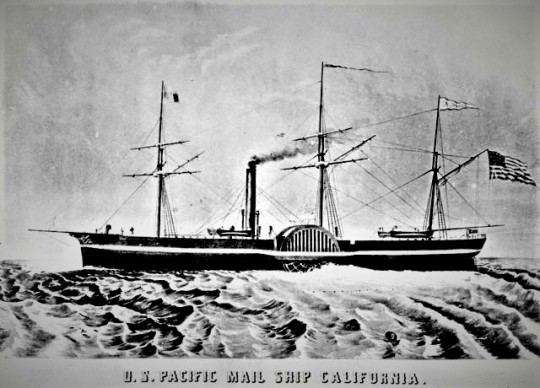
Illustration of the steamship SS California, the first ship of the Pacific Mail Steamship Company. Only a few passengers were on board when the ship left New York on October 6, 1848. By the time the ship reached its stop on the Panama’s Pacific coast, word had spread of the great new find of gold in California. Over 700 people tried to get passage on the ship in that harbor. The Pacific Mail agent managed to cram 365 people aboard the ship before it set sail for California. The ship and passengers reached San Francisco on February 28, 1849, where all but one member of the crew deserted the ship for the goldfields. The ship was lost in a wreck off the Peruvian coast in 1894. (Illustrator unknown, from the collection of the US National Postal Museum)
The discovery of gold in the Sierra Nevada in 1849 produced a massive influx of people to California
from all over the world, including China. According to historian Thomas W. Chinn, “Hong Kong was the general rendezvous for departure to California. The emigrants usually stayed at dormitories provided by the passage brokers or at friends' and relatives' homes until the day of embarkation. The earliest ships between China and California were sailing vessels, some of which were owned by Chinese. . . . However, most of the ships in the early days bringing Chinese immigrants were American or British owned. At the time the shipping of Chinese to California was a very profitable business.”
The voyage in sailing vessels across the Pacific varied from 45 days to more than three months. Chinese passengers typically spent most of the voyage below decks in the overcrowded steerage. Conditions aboard the ships varied with the ship and shipmaster. In March 1852, 450 Chinese arrived in the American ship Robert Browne bound for San Francisco objected to the captain's order to cut off their queues as a hygienic measure. They rebelled, killed the captain and captured the ship. According to Chinn, “health conditions on the bark Libertad were so bad that when she sailed into San Francisco harbor in 1854, one hundred out of her five hundred Chinese passengers and the captain had died during the voyage from Hong Kong.”
In 1866, the Pacific Mail Steamship Company (“PMSSC”) entered the cargo and passenger trade to and from the Orient. As the sole federal contract-carrier for US mail, the PMSSC became a key mover of goods and people and a key player in the growth of San Francisco, California.
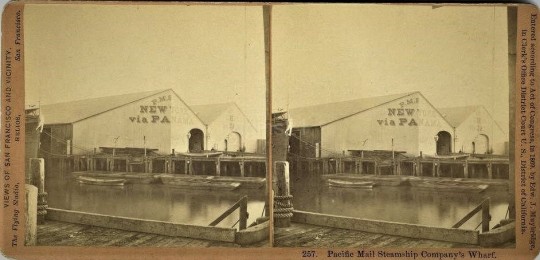
“257. Pacific Mail Steamship Company’s Wharf” c. 1869 -1871. Photo and stereoview by Eadweard J. Muybridge (from a private collection). The Pacific Mail’s wharf at the foot of Brannan Street in San Francisco at the approximate location of its old Pier 36. This was the first waterside view of the city for virtually every Chinese immigrant making landfall in San Francisco.
For the first six decades of the Chinese diaspora to the US, the sheds provided the first experience for every Chinese immigrant on California soil.
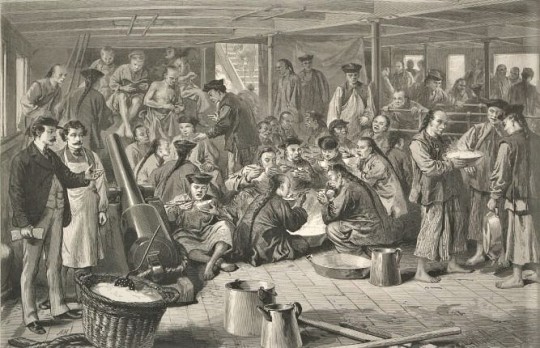
“Chinese Emigration to America,” no date. Illustrator unknown (from the collection of the Bancroft Library). This illustration shows life aboard a Pacific Mail Steamship Co. ship making the passage from China to San Francisco.
Amidst the Gold Rush and burgeoning industries like mining, agriculture, and construction, Chinese immigrants from southern China flocked to California. The PMSSC’s sheds, located along San Francisco’s waterfront, played a crucial role in handling cargo, passengers, and immigrants who arrived via steamships. Serving as pivotal infrastructure, they provided storage space for goods, customs processing areas, and waiting areas for passengers.

Pacific Mail Steamship Co. dock, c. 1864- 1872. Photograph by Carlton Watkins, probably derived from Watkins Mammoth Plate CEW 611. (from a private collection, the Roy D. Graves Pictorial Collection, Bancroft Library; and the San Francisco National Maritime Museum). In this elevated view east from Rincon Hill to the Pacific Mail dock, sidewheel steamer vessels identified by the SF National Maritime Museum as the SS Colorado (built in 1865 and scrapped in 1879), the steamer SS Senator at right (1865-1882), and various sailing ships are seen with Yerba Buena Island in the background. The Oriental Warehouse (built 1867 and still standing at 650 Delancey Street) is at left. The opensfhistory.org site identifies the three-part wooden structure at center as the Occidental Warehouse, used for grain storage, with blacksmith and boiler shops to the left. Ads for C.C. Hastings & Co. Clothing at Lick House can be seen on the fence.
Even as the Gold Rush waned, the PMSSC initiated in 1867 the first regularly scheduled trans-Pacific steamship service, connecting San Francisco with Hong Kong, Yokohama, and later, Shanghai. This route facilitated an influx of Japanese and Chinese immigrants, enriching California’s cultural diversity.
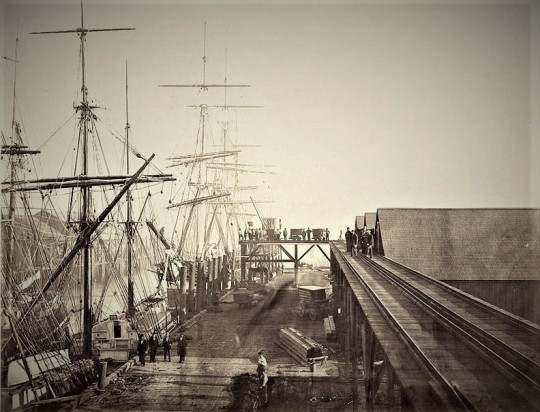
Pacific Mail Steamship Co. docks, c. 1871. Photograph by Carleton Watkins (from a private collection).
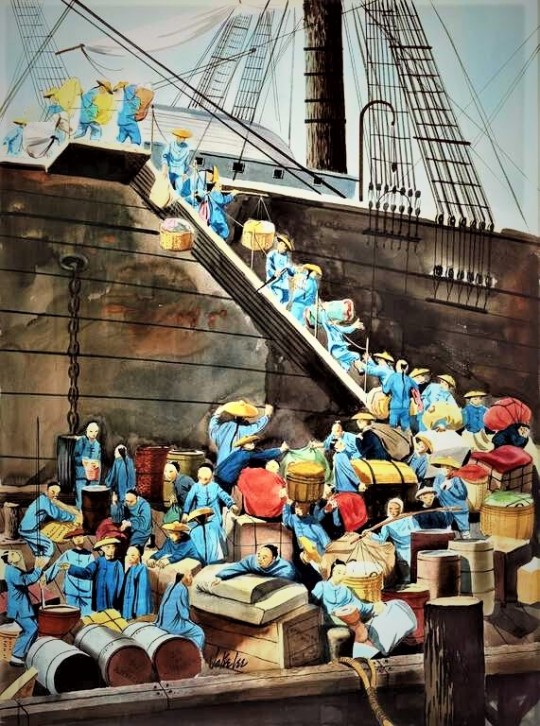
“Disembarking.” Painting by Jake Lee (from the collection of the Chinese Historical Society of America). In this watercolor, one among a suite of paintings commissioned by Johnny Kan for his then-new Kan’s Restaurant on San Francisco’s Grant Avenue in Chinatown, artist Jake Lee depicted a stylized unloading of mostly male passengers at the Pacific Mail Steamship Co. wharf in San Francisco.
When a ship dropped anchor at the dock in San Francisco, the emigrants finally set foot on American soil. A journalist for the Atlantic Monthly in 1869 described the debarkation of 1,272 Chinese as follows:
"… a living stream of the blue coated men of Asia, bearing long bamboo poles across their shoulders, from which depend packages of bedding, marring, clothing, and things of which we know neither the names nor the uses, pours down the plank…. They appear to be of an average age of twenty-five years… and though somewhat less in stature than Caucasians, healthy, active and able bodied to a man. As they come down upon the wharf, they separate into messes or gangs of ten, twenty, or thirty each, being recognized through some to us incomprehensible free-masonry system of signs by the agents of the Six Companies as they come, are assigned places on the long broad shedded wharf [to await inspection by the customs officers]."
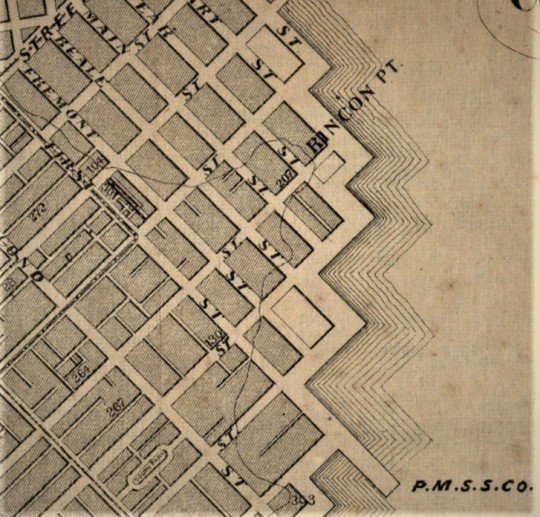
A detail from the "Bancroft's Official Guide Map of San Francisco" of 1873. The lower right corner of the image locates the Pacific Mail Steamship Co. pier at the foot of First Street (at Townsend) running in a southeasterly direction. According to local historian Garold Haynes, "that was before the seawall realignment of the waterfront in the late 1870s."
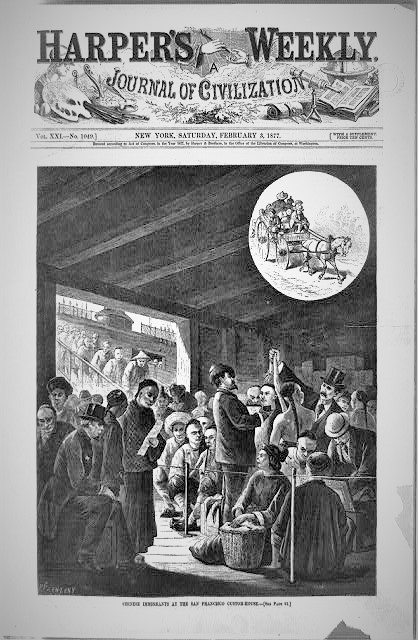
“Chinese Immigrants by The San Francisco Custom House” Harper’s Weekly, February 1877. Illustration by artist Paul Frenzeny (from the collection of the Library of Congress). Chinese immigrants wait for processing in the Pacific Mail Steamship Co.’s sheds while more arrivals from China disembark from the gangway seen in the background.
For many of the immigrants arriving on Pacific Mail steamships, the sheds served as the initial point of contact with the United States. Additionally, the sheds served as immigration processing areas, where Chinese immigrants underwent inspections and screenings. The sheds were a crowded and unsanitary place. Immigrants were often forced to wait for days in the sheds before they could be processed. They were also subjected to medical examinations and interrogations by immigration officials.
As the Atlantic Monthly writer described in 1869 described after each group passed through customs, “. . .They are turned out of the gates and hurried away toward the Chinese quarters of the city hv the agents of the Six Companies. Some go in wagons, more on foot, and the streets leading up that way arc lined with them, running in 'Indian file' and carrying their luggage suspended from the ends of the bamboo poles slung across their shoulders . . .”

In a political cartoon (c. 1888, based on the reference to the Republican Party presidential ticket of 1888 in the upper left corner of the image), Chinese immigrants stream off ships onto the wharves of the Pacific Mail Steamship Co. and the Canadian Pacific Steamship Co. and directly into the factories of San Francisco Chinatown and beyond. Illustrator unknown (from the collection of the Bancroft Library).

"New Arrivals." Date, location, and photographer unknown. The wagon on which the Chinese are riding, presumably having come directly from the Pacific Mail Steamship Co. wharf to San Francisco Chinatown, appears very similar to the 1877 configuration seen in the upper right corner of the preceding Harper's Weekly illustration.
The surge in Chinese immigration led to anti-Chinese sentiments, as reported in the illustrated magazines of the era. The arrival was often violent, as hoodlum elements would sometimes throw stones, potatoes and mud at the new immigrants. After the arrival in Chinatown, the newcomers were temporarily billeted in the dormitories of the Chinese district associations (citing Rev. Augustus W. Loomis, “The Chinese Six Companies,” Overland Monthly, os. v. 1 (1868), pp. 111-117).

“Hoodlums” Pelting Chinese Emigrants On Their Arrival At San Francisco” c. 1870s. Illustrator unknown (from a private collection). A rough sketch of the Pacific Mail Steamship Co. sheds appears in the background.
In San Francisco, local efforts to stop Chinese immigrants moved beyond the sheds and onto the arriving ships, which often became the focal points for Chinese litigants in the local and federal courts.
For example, in August of 1874, the Pacific Mail Steamship Company’s vessel Japan arrived in San Francisco carrying around 90 Chinese women. The Commissioner of Immigration boarded the ship and conducted interviews with about 50 to 60 of these women. From his inquiries, he concluded that 22 of them had been brought to San Francisco for “immoral purposes,” as reported by the Daily Alta California on August 6, 1874. When the Pacific Mail Steamship Company refused to provide the necessary bonds, the Commissioner instructed the ship’s master to keep the 22 women on board.
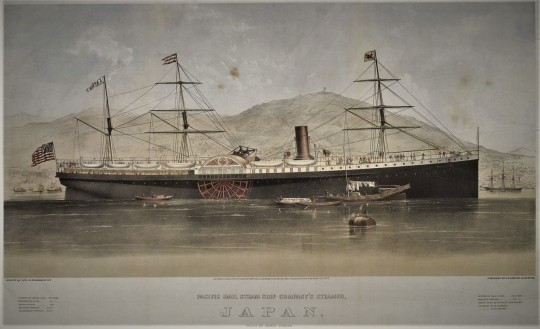
Pacific Mail Steam Ship Company’s Steamer, Japan, c. 1868. Print created by Endicott & Co. (New York, N.Y.), Menger, L. R., publisher (from the collection of The Huntington Library). Junks in the foreground, and, to the left in the background, Hong Kong’s Victoria Peak with semaphore at top appears in the background, center right. The SS Japan is flying the American flag from its stern, a Pacific Mail house-flag from the middle mast, and a pennant with the vessel’s name from the aft mast. A flag flying from the first mast appears to be a red dragon on a yellow field. Print includes vessel statistics and the name of the builder, Henry Steers.
Promptly, attorneys representing the detained women sought legal recourse by requesting a writ of habeas corpus from the state District Court in San Francisco. For two days, legal representatives from various parties engaged in debates over whether the Commissioner’s authority under the law was valid and whether the so-called “Chinese maidens” were indeed involved in prostitution. Reverend Mr. Gibson, who claimed expertise in this area, confidently asserted that Chinese prostitutes could be easily identified by their attire and behavior, likening the distinction to that between courtesans and respectable women in the city. He concluded that only half of the women were destined for prostitution. Ultimately, the District Court ruled that all the women should remain detained and ordered them to stay on the ship.
Shortly before the ship Japan was set to depart, the County Sheriff boarded and brought the 22 women ashore based on a writ of habeas corpus issued by the California Supreme Court. Two weeks later, Justice McKinstry, in a brief opinion on behalf of the court in Ex Parte Ah Fook, 49 Cal 402 (1874), affirmed the lower court’s decision, validating the Commissioner’s authority as a legitimate exercise of the state’s police power.

“258. Steamship Japan in California Dry Dock, Hunter’s Point, San Francisco”c. 1869. A side view of the steamship Japan of the Pacific Mail Steamship Company at the dry dock at Hunters Point. Photograph by Thomas Houseworth (from the Marilyn Blaisdell Collection). The ship would become the setting for a controversial habeas corpus case involving the entry of 22 Chinese women over the objections of state authorities in the case of Ex Parte Ah Fook, 49 Cal 402 (1874).
A third writ of habeas corpus presented the matter to the United States Circuit Court, presided over by Justice Stephen J. Field and Judge Ogden Hoffman. During the oral arguments, Justice Field made it clear that he wouldn’t dismiss constitutional arguments as easily as the state Supreme Court had, emphasizing the principle of equal treatment for citizens and non-citizens.

The Pacific Mail Steamship Co. derrick and coal yard in San Francisco, c. 1871. Photograph by Carleton Watkins (from the collection of the California Historical Society).
In the ruling, Justice Field discharged the petitioners, stating that California’s statute surpasses a state’s legitimate police power and violates the principle of “the right of self-defense.” He noted that the statute could exclude individuals who posed no immediate threat to the state. Judge Hoffman, in a concurring opinion, went further, suggesting that the states should have no control over immigration due to the exclusive nature of the commerce clause.
Although the Circuit Court decision released the Chinese women, while limiting the state’s power over Chinese entry, the Japan case reinvigorated California’s efforts to deter Chinese immigration. The influx of Chinese immigrants coupled with high unemployment in the late 1870s allowed Dennis Kearney of the Workingmen’s Party to target the Chinese as scapegoats. The “Chinese must go” movement gained traction, with both the Republican and Democratic parties adopting anti-Chinese stances.

The Pacific Mail Steamship Co.’s wharf in San Francisco. Photograph by Carleton Watkins (from the collection of the Fine Arts Museums of San Francisco).
During the San Francisco Riot of 1877, the sandlot mob attacked the wharves of the Pacific Mail Steamship Company, because this shipping line represented the primary mode of transportation for America-bound Chinese immigrants headed to California. Although the steamships were not burned, the wharves were partially wrecked. Rioters also burned the lumber and hay yards adjacent to the Pacific Mail wharves.
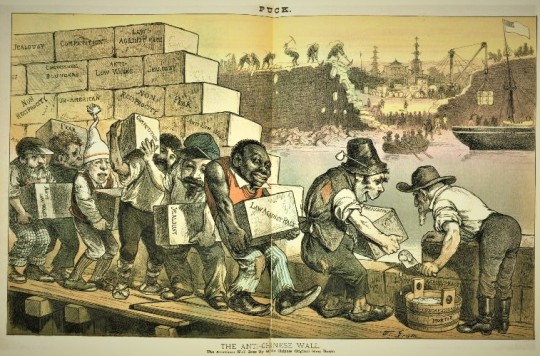
“The Anti-Chinese Wall – The American Wall Goes Up as the Chinese Original Goes Down.” Illustration by Friedrich Graetz in Puck of March 29, 1883 (v. 11, no. 264). The cartoon portrays a multi-ethnic coalition gathered on the wharf to halt Chinese immigration in the aftermath of the passage of the Chinese Exclusion Act in May 1882.
California was able to transfer its racial grievances and resentments to the national stage, culminating in the passage of the Chinese Exclusion Act in 1882. This marked a turning point in the history of Chinese immigration and had profound effects on the Chinese-American community. The Act severely restricted Chinese immigration to the United States.
The use the PMSSC’s sheds posed significant challenges to federal and state attempts to enforce the Exclusion Act (and its punitive extension in the Geary Act of 1892), against all Chinese, regardless of birth or immigration status.
As an article in the San Francisco Call of May 12, 1900, details, the chaotic scene at the Pacific Mall dock where Chinese immigrants disembarked from the ship Coptic was typical for that era. In the Coptic case, federal officials were observed allowing the landing of alleged "coolies" despite the spirit of the exclusion act, causing outrage. The detention shed, initially meant for temporary housing, had become a long-term residence for over 370 Chinese immigrants, generating substantial profit for the PMSSC. The maintenance of this facility posed several concerns, including violations of health regulations and potential disease outbreaks. The Call decried the authorities' negligence in enforcing the law and highlighted the role of a Chinese "ring" in facilitating fraudulent practices and illegal immigration. With multiple ships arriving with more immigrants, the newspaper called for investigation and reform.

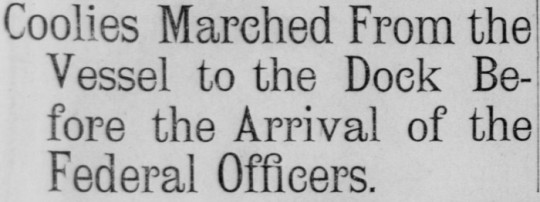


Headlines from the The Call of May 12, 1900, regarding the crowd of detained Chinese immigrants disembarked from the Pacific Mail ships Coptic and America Maru, the lack of security in the Pacific Mail sheds, and alleged immigration fraud.

Illustrations and photographs from the San Francisco Call of May 12, 1900, for its report about the crowd of detained Chinese immigrants disembarked from the Pacific Mail ships Coptic and America Maru, the lack of security in the Pacific Mail sheds, and alleged immigration fraud.
For Chinese and other immigrants and travelers from Asia, the transpacific journey, and even entering San Francisco Bay itself, posed hazards. The dangers were never more evident than in the case of the SS City of Rio de Janeiro. Launched in 1878, this steamship had been an essential component of the Pacific Mail Steamship Company's fleet. Its routes connected pivotal locations such as San Francisco, Honolulu, Yokohama, Japan, and Hong Kong, and the ship had played a role in America's expansion into the Far East and the Pacific in the aftermath of the Civil War and during the Spanish American War.

“A Thousand Boys in Blue S.S. Rio de Janeiro bound for Manila” copyright 1898. Published by M.H. Zahner (from the collection of the Robert Schwemmer Maritime Library). Built by John Roach & Son in 1878 at Chester, Pennsylvania, this vessel had served as a vital link between Asia and San Francisco, regularly transporting passengers and cargo. This stereograph shows its charter by the federal government for use as a military troop transport during the Spanish American War.
On the morning of February 22, 1901, the SS City of Rio de Janeiro commenced its approach to the Golden Gate and the entrance to San Francisco Bay. They had sailed with a crew that was mostly Chinese. History indicates that approximately 201 people were aboard the Rio de Janeiro, as follows: Cabin passengers 29; second cabin, 7; steerage (Chinese and Japanese), 68; white officers, 30; Chinese crewmen, 77. Of the Chinese crewmen, only two spoke English and Chinese. During the long voyage, the ship’s officer gave orders by using signs and signals. The ship’s equipment and lifeboat launching apparatus appeared to be in good working order and were capable of being lowered in less than five minutes.
Near the location of the future location of the Golden Gate Bridge, tragedy struck as the SS City of Rio de Janeiro. In the dense morning fog that obscured the surroundings, the ship collided with jagged rocks on the southern side of the strait, near Fort Point. The vessel’s non-watertight bulkheads led to rapid and unstoppable flooding. In a mere ten minutes, the SS City of Rio de Janeiro succumbed to the relentless forces of the sea.
The majority of the passengers, many of whom were Chinese and Japanese emigrants in steerage, were caught unaware in their cabins as the ship sank. The toll was staggering, with 128 lives lost out of the 210 souls on board. Of the 98 Asians reportedly on board the ill-fated ship, only 15 passengers were rescued, and 41 Chinese crewmen survived.
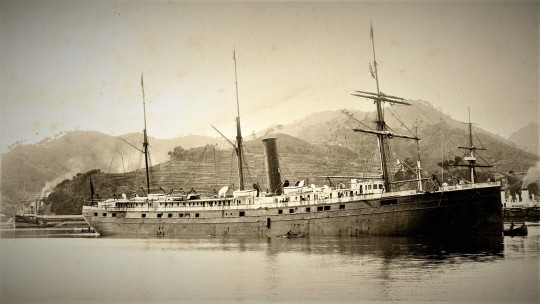
The SS City of Rio de Janeiro in Nagasaki, Japan, c. 1894. Photographer unknown (from the collection of the San Francisco Maritime National Historical Park). The ill-fated ship, which transported passengers and cargo between Asia and San Francisco, sank seven years later after running into rocks near the present site of the Golden Gate Bridge. The never-salvaged shipwreck rests 287 feet underwater.
The sinking of the SS City of Rio de Janeiro represented the deadliest maritime disaster at the San Francisco Bay's entrance, forever etching its name in the annals of maritime history as the “Titanic of the Golden Gate,” drawing a sad parallel to another infamous shipwreck. Today, the case serves as a reminder of the unpredictable forces of nature and the inherent dangers of maritime travel to which thousands of Chinese immigrants and other Asian travelers subjected themselves to gain a better life in America.
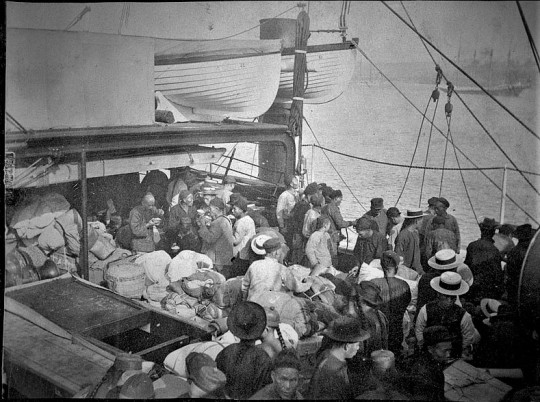
"Chinese Passengers on Deck, 1900–15," enroute to Hawaii. Photographer unknown (from the collection of the Hawaii State Archives). Chinese passengers, some eating from rice bowls, crowd the deck of a steamship. After the Exclusion Acts, the numbers of Chinese voyaging to the US had decreased sharply.
Despite reduced immigration due to the passage of successive exclusion acts in 1882 and 1892, the PMSSC's sheds remained operational, their purpose shifting from off-loading immigrants to facilitating trade and commerce between the east and west coasts of the US.

The Pacific Mail Steamship shed on the San Francisco waterfront at the turn of the century. Photograph attributed to Arnold Genthe. Located at the former pier 36, where Brannan Street runs into the Embarcadero, the immigration station was moved to Angel Island in 1910. Pier 36, the last of the docks at Brannan was torn down in 2012. In just one year, 1852, 25,000 Chinese entered California for the Gold Rush and other opportunities. Chinese America began here.
The convergence of the Central Pacific and Union Pacific railroads in Utah in 1869, had started the process of eroding the Pacific Mail's profitability on the Panama-to-San Francisco route over the ensuing decades, eventually leading to the sale or redirection of many of its ships to other routes.

The Pacific Mail Steamship Co. offices on the southeast corner of Market and First streets in downtown San Francisco, c. 1896. Photographer unknown (from a private collection).
The landscape changed drastically in 1906, when a devastating earthquake and subsequent fire struck San Francisco, including the PMSSC’s wharf facilities. Although destroyed during 1906 disaster, the PMSSC’s sheds were rebuilt shortly thereafter. The sheds continued to be used for detaining and interrogating Chinese immigrants until the opening of immigration station facilities on Angel Island in 1910 for the processing Chinese and other immigrants.
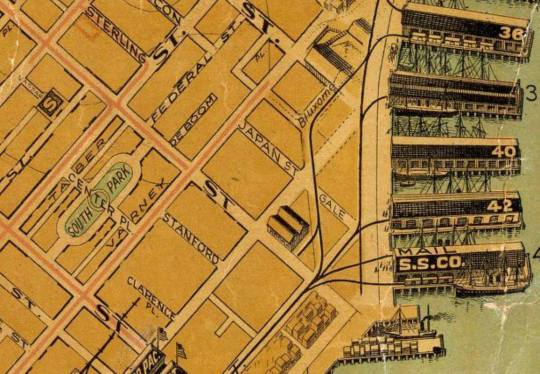
A detail from the August Chevalier Map of 1915. The PMSSC sheds were located on Pier 36 at the intersection of Brannan and First Street.
The legacy of the PMSSC’s sheds, intertwined with their role at the inception of Chinese immigration to California and the US, is deeply rooted in San Francisco's maritime and Chinese American history. Both the company's operations and the experiences of the first wave of the Chinese diaspora arriving on American shores by steamships will remain forever part of the socio-economic dynamics of 19th-century San Francisco and the American West.
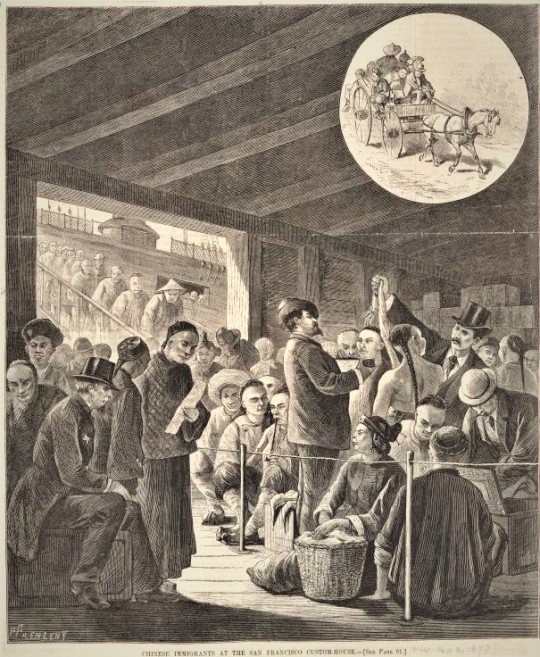
“Chinese Immigrants by the San Francisco Custom House” c. 1877. Detail of the magazine cover illustration by artist Paul Frenzeny for the Harper’s Weekly (from the collection of the New York Public Library.
[updated 2023-10-17]
#Pacific Mail Steamship Co.#Pacific Mail sheds#Chinese immigration detention#Carleton Wtakins#Paul Frenzeny#Harper's Weekly#SS Japan#In re Ah Fook#Stephen Field#Eadweard Muybridge#Pier 36 San Francisco
5 notes
·
View notes
Text
My Sense of Place and Connection with Nature
My current relationship with nature is very strong, I would say I enjoy my time most when I am outside directly with nature. I think this connection grew as a young child as I have a family cottage, not too far from Bancroft Ontario, and have spent a great deal of time growing up here. From as long as I can remember I have spent time fishing, hiking, swimming, and any other outdoor activities you could think of at my cottage. Although I have always enjoyed spending time fishing off the dock or canoeing through the lake, I did not realise until I started my degree that I am so lucky to have already spent so much time with nature.
According to the text, Interpreting Cultural and Natural Heritage for a Better World, a “sense of place” can be a location that offers a strong personal connection to the place. I can confidently say I have felt a “sense of place” at my cottage. Specifically, I would say my Dad has offered this to me as he introduced me to my cottage and has done so many activities with me here. It is where I go to feel the true version of myself, as well as where I go to have fun and deal with hard times. I feel the most connected to my cottage when I am in the middle of the lake on a boat or canoe because it puts the world into perspective and reminds me of the big picture.

In addition to spending ample time at my cottage I also had the opportunity of being a part of the BIOL 4410 Field Ecology Course with the University of Guelph. I participated in this course this past summer and spent two weeks in a cabin with my fellow classmates in Algonquin Park. This experience only strengthened my relationship with nature, allowing me to feel connected and united with my environment. During this course I felt a sense of place to be at Algonquin Park, I learned that the location is more than just a landscape and offers so much more. There was so many people responsible for this feeling, such as the professor, the TA and even fellow classmates. The beautiful scenery not only offers a place of joy, but it also felt refreshing. I learned that being outdoors is a place where I can feel myself and experience a deeper pleasure with the incredible scenery that our earth has to offer.

Lastly, I would like to mention one more location where I have felt a deep connection with nature and where I have felt a sense of place, this being Alberta. Thanks to a friend of mine that lives here, I was able to go visit for a few days. I traveled to Canmore, Alberta over reading week last February. I felt an overwhelming connection with nature when standing on top of Sulphur Mountain. This was an entire landscape I have never seen before, and you could see an entire city from my stance, which was incredible I felt like it was more than just a place because I was completely stress free and content with my life.

6 notes
·
View notes
Photo
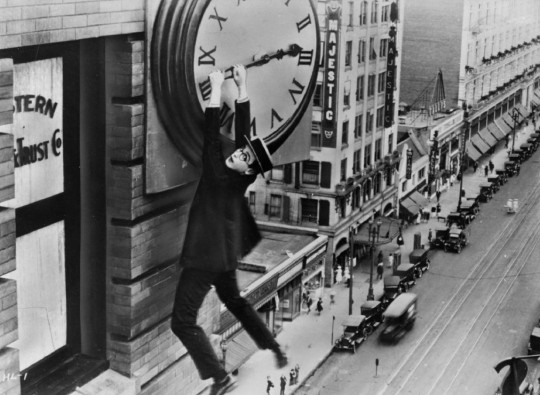
(My favourite films by decade are below the cut)
Tonight, I watched 'Safety Last!'—the slapstick silent comedy from 1923 with the indelible 20-minute clocktower scene—which means that I've now seen at least one film from every year since 1891, shortly after the invention of motion pictures (I've also seen the few recordings that came before that, such as the 12-slide ‘Horse in Motion,’ but there are gaps in the years, and we're talking about film segments that were roughly 2 seconds in length—films didn't even get to 3 minutes in length until 1898; the first hour-long movie was in 1906).
I've got 916 movies on my list (it's probably more than that; my mind has no idea if it's ever seen a sequel). I posted a while ago about only having 600 movies logged; to fill out the list I went through box office charts to identify what I'd likely seen in the 80s, 90s, 00s, etc. but had forgotten about.
I was missing so many from the 90s, when we had our family movie nights. On average, from 1989 to 2000, I saw 28 films per release year. That dropped to 15 once I finished undergrad, and has remained pretty constant. Going by the box office charts, I don't feel I've missed much of what I've wanted to see; there have been far too many sequels and metaverses, which simply don't interest me. Over these COVID years, I've been watching more than just the newest releases, catching up on earlier decades; I've seen 173 that were released before I was born (most pre-1970 releases are from COVID onward).
My favourite films by decade (because I like lists):
1890-99: The Astronomer's Dream (1898). Directed by Georges Méliès; the first film as real artistic production; multiple scenes and stages, special effects, 3 minutes.
1900-09: The Great Train Robbery (1903). The first epic action movie, at 13 minutes. Fantastic production value; it's got better cinematography and editing than a lot of current movies.
1910-19: I'm unsure. ...perhaps The Conquest of the Pole (1912), another by Georges Méliès. I need to see more films from this decade.
1920-29: Wings (1928) and Metropolis (1927), take your pick. One, the Oscars' first Best Picture winner and the benchmark for romantic drama (and with Clara Bow!), the other the most impressive film ever made.
1930-39: My Man Godfrey (1936), my favourite Carole Lombard role (she's a fuckin' hoot!).
1940-49: Citizen Kane (1941), Casablanca (1943) are both fine choices, but my choice would be His Girl Friday, because snappy dialogue is like a hit of cocaine.
1950-59: Roman Holiday (1953). Audrey Hepburn and Gregory Peck are both so charismatic; the chemistry here is palpable.
1960-69: The Great Escape (1963) is an excellent pick, as is Ingmar Bergman's Persona (1966). I'd take The Graduate (1967); it felt so unique, not your typical love story, and Anne Bancroft's vulnerable seductiveness turn felt so dangerous.
1970-79: This was such a great decade (Harold and Maude, Chinatown, Monty Python and the Holy Grail, Up in Smoke) ...but Apocalypse Now (1979) is my all-time top pick.
1980-89: The Gods Must Be Crazy (1984). Timeless. Wholesome. Simple and effective.
1990-99: I'm trying to pick one film out of the 300 that I've seen from this timeframe, so maybe one [Ed. note: or more] per year? Edward Scissorhands (1990), Point Break (1991), Wayne's World (1992), Jurassic Park/Schindler's List (1993), The Madness of King George/The Hudsucker Proxy/Quiz Show/Malcolm X (1994), Babe (1995; yes, the pig movie), The Young Poisoner's Handbook (1996), Life is Beautiful (1997; La vita è bella), ...not sure on 1998...maybe Waking Ned Devine/Pleasantville..., Office Space/Lock, Stock, and Two Smoking Barrels (1999).
2000-09: Gladiator/Girl, Interrupted/American Psycho (2000), Amélie/Ali (2001), Super Troopers/Secretary (2002), Dogville (2004), No Country for Old Men (2007), There Will Be Blood (2008), Dead Snow (2009).
2010-19: The Artist (2011), Argo (2012), Beasts of No Nation (2015), Rogue One (2016), Coco (2017), The Nightingale/Parasite/Knives Out (2019).
2020-23: One Night in Miami... (2020), Nitram (2021).
If you’ve made it this far, thanks for watching. 🎞️
6 notes
·
View notes
Text
Amazon Watch Party Watch: Gorilla at Large (1954)
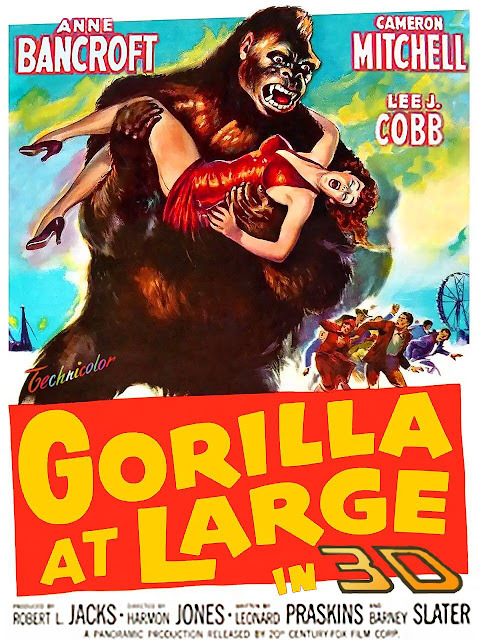
Watched: 02/03/2023
Format: Amazon Watch Party
Viewing: First
Director: Harmon Jones
So, to my complete surprise, I liked this movie semi-unironically.
I found it weird that this movie starred fairly big names for the time. Not huge stars, but knowable names and more than one of them. It has Raymond Burr, Lee J. Cobb, a young Lee Marvin, Cameron Mitchell (before he spiraled into camp), and Anne Bancroft here to remind you she is, indeed, a very good idea. I was not familiar with Charlotte Austin, who plays the virginal character, but who could scream like crazy and had great hair (and was in another gorilla movie in 1958 called The Bride and the Beast, penned by Ed Wood Jr.).
At around the 70% mark of the movie, I think it was Jenifer who pointed out "this is gorilla noir", and she was not wrong. This is absolutely murder mystery noir, set against the backdrop of a carnival, with a gorilla as a character, and plenty of intrigue to go around. The movie is knowing enough that it constantly plays with expectations, and I had no idea how this thing would wrap up until the end.
It's also, visually, very interesting. Shot at Nu Pike Amusement Park in Long Beach. I thought it was the same location as Woman on the Run/ Gun Crazy and others, and was very wrong. My takeaway is that California had some great amusement options in the 20th century. (The Burglar was filmed in New Jersey, so I was way off there.) But as something shot originally for 3D presentation, and in bright technicolor, it's a fascinating bit of visual cotton candy, including a dynamic scene with a mirror maze (that I'm not clear on how it was shot without showing the crew standing behind the camera, tbh).
It's not challenging the AFI Top 100 as an underserved, underseen classic, but it's *interesting*. Including the bizarre decisions that led to the finale.

https://ift.tt/R9rc3Hz
from The Signal Watch https://ift.tt/wWcnphD
2 notes
·
View notes
Video
youtube
Homecoming | FULL MOVIE | Drama | 1996 | Anne Bancroft
In this heroic odyssey, thirteen-year-old Dicey Tillerman struggles to keep her family together after she and and her siblings, James (11), Maybeth (9) and Sammy (6) are abandoned in a shopping center parking lot by their distraught mother Liza.
A great movie!!!!!!!!
6 notes
·
View notes
Text
Media List 2023
Ok I’m making a list of the things I want to watch/read/have been suggested to me etc before I lose track lol and so people can look if they want to see I guess. I’m putting suggestions on this list too even if I haven’t looked into them very hard and I think it goes without saying that just because it’s on the list doesn’t mean I’ll get to it.
None of these are in any real order, but I’m doing a numbered list so I can use a random number generator if I’m getting decision paralysis. I’m putting where I can personally watch them for reference, they may be available other places that I don’t have a subscription to.
Movies
Pinocchio (2022), Netflix
Glass Onion (2022), Netflix
Girl in the Picture (2022), Netflix
Pan’s Labyrinth (2006), rent/buy
Bird’s of Prey (2020), HBOMax, Owned
Carol (2015), Prime
Blue is the Warmest Color (2013), rent/buy
Love Simon (2018), rent/buy
Moonlight (2016), rent/buy
Parasite (2019), Hulu
The Batman (2022), HBOMax
Lighthouse (2019), rent/buy
Bladerunner 2049 (2017), Hulu
Vertigo (1958), Rent/buy
Pleasure Unwoven (2009), youtube?
Weird: The Al Yankovich Story (2022), ?
The Last Unicorn (1982), Prime
The Green Mile (1999), rent/buy
Spirited Away (2001), HBOMax
Princess Mononoke (1997), HBOMax
Everything Everywhere All At once (2022), rent/buy
Possession (1981), rent/buy
Bicycle Thieves (1948), HBOMax
The Menu (2022), HBOMax
Amélie (2001), ?
Brokeback Mountain (2005), Netflix
Wall-E (2008), rent/buy
Black Girl (1956), rent/buy
Yi Yi (1999), rent/buy
Sunset Boulevard (1950), rent/buy
Imitation of Life (1959), rent/buy
The Apartment (1960), Paramount+
Taxi Driver (1976), Paramount+
Seven Samurai (1954), HBOMax
The Godfather (1972), Prime
2001: A Space Odyssey (1968), HBOMax
Tokyo Story (1953), HBOMax
The Invitation (2022), Netflix
Shows
Castlevania, Netflix (started and need to finish)
The Haunting of Bly Manor, Netflix
Midnight Mass, Netflix
Fleabag, Prime
Xena, ?
The Two People Who Can’t Fall in Love, ?
Dead End: Paranormal Park, Netflix
Wellington Paranormal, HBOMax
James Acaster comedy, Netflix
Centaurworld, Netflix
Tuca & Bertie, Netflix
Kid Cosmic, Netflix
What We Do In the Shadows, Hulu
Veronica Mars, Hulu
Defunctland, YouTube
Ted Lasso, Apple+
Books
How to Hide an Empire by Daniel Immerwahr
Unmasking Autism by Devon Price
The Roots of Desire by Marion Roach
Why Does He Do That? by Lundy Bancroft
The Kalevala
Armed Struggle: The History of the IRA by Richard English
The Age of Surveillance Capitalism by Shoshana Zuboff
ADHD After Dark by Ari Tuckman
Your Brain’s Not Broken by Tamara Rosier (audiobook)
Misfit Mage by Michael Taggart
The Ballad of Songbirds and Snakes by Suzanne Collins (audiobook)
The Affair of the Poisons by Anne Somerset
Where the Crawdads Sing by Delia Owens
Fun Home by Alison Bechdel
The Ex-Con, Voodoo Priest, Goddess, and the African King by William Jones
My Name is Ron by the family of Ron Goldman
I did it by Fred and Kim Goldman
Death of Innocence by Mamie Till-Mobley
The Kitchen God’s Wife by Amy Tan
Colorless Tsukuru Tazaki and his Years of Pilgramage by Haruki Murakami
If Walls Could Talk by Lucy Worsley
How to be an Artist by Jerry Saltz
The Blood Never Dried by John Newsinger
Bright Dead Things by Ada Limón
History of the World in 6 Glasses by Tom Standage (audiobook)
A Woman of No Importance by Sonia Purnell (audiobook)
Hate to Want You by Alisha Rai (audiobook)
Lazy Does Not Exist by Devon Price (audiobook)
How to be an Artist by Jerry Saltz (gift)
An Anthology of Finnish Folktales edited and translated by Helena Henderson
Games
Venba (spring 2023)
Dordgone (spring 2023)
Storyteller (March 23, 2023)
Fe (skipping, it makes me cranky)
LOVE
A Short Hike
To The Moon
Finding Paradise
Night in the Woods
Life is Strange one and two
Spiritfarer
Life is Strange: True Colors
Powerwash Simulator
5 notes
·
View notes
Photo
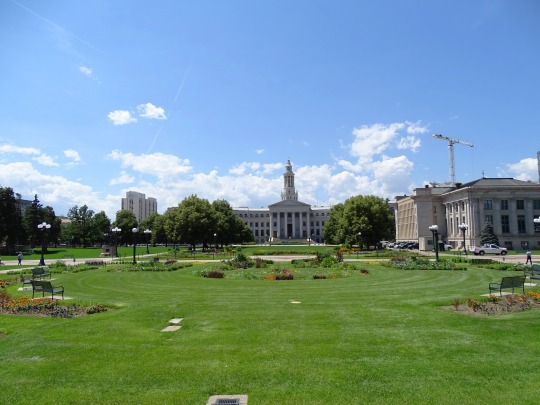

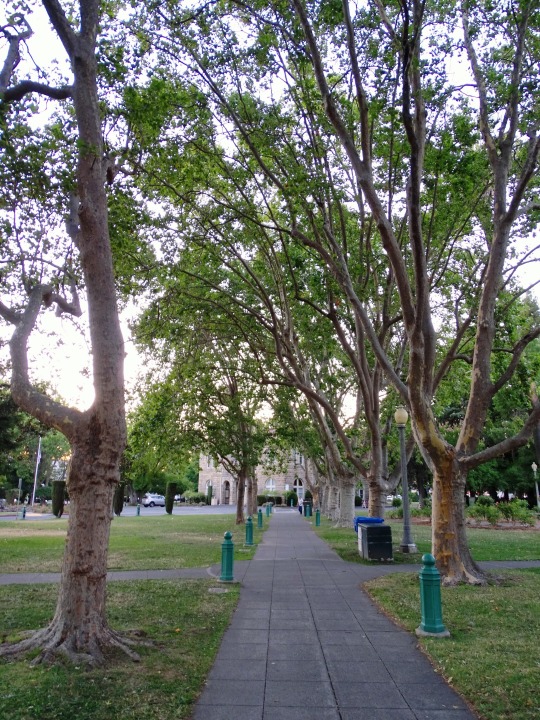
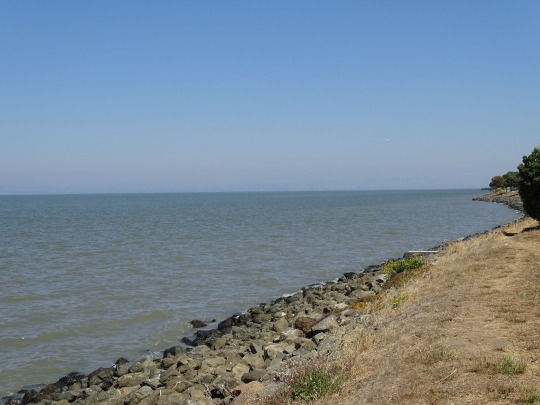
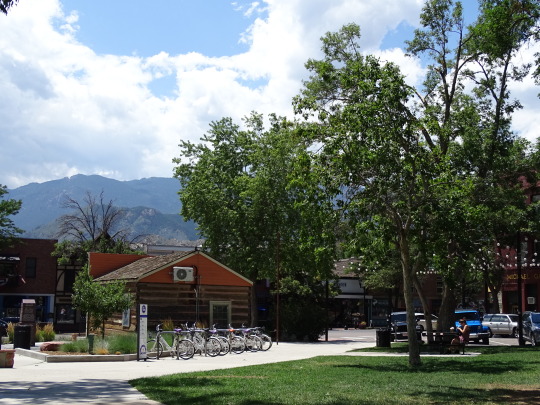
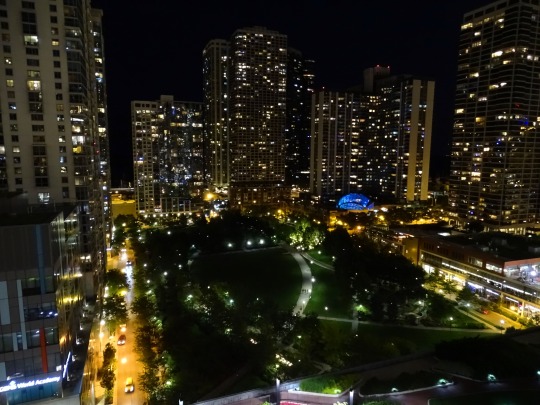
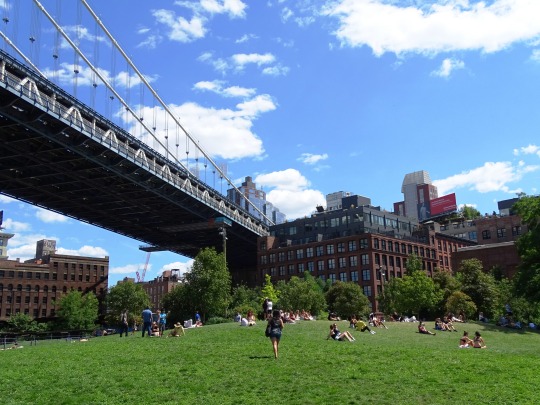
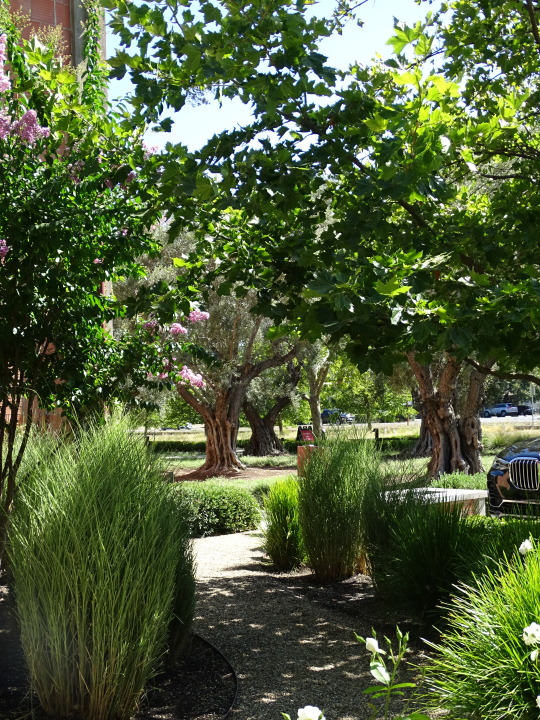


National Take a Walk in the Park Day
When cities are being designed one of the primary things they ensure to make space for is city parks. From small parks the size of just a couple of blocks to large ones that cover acres of land, city planners know the importance of providing green areas for people to go.
National Take a Walk in the Park Day celebrates these small excursions and the differences they can make to our mental, physical, and emotional health.
History of National Take a Walk in the Park Day
This day was founded to help people reconnect with the wilder spaces within our civilized world. Thousands of people all over the country walk in local parks, exploring the wildlife and beauty of the natural world around them.
During these walks many opt to bring cameras so they can take pictures of the beauty they find, others opt to bring a book and enjoy the peace of the natural space. Jogging, playing games, drawing pictures from nature, all of these are things people do when they go out and enjoy time in the park.
Getting out into nature has been proven to have a number of therapeutic effects on those who take the time to do it. Their stress levels go down, their heart and mind feel refreshed, their creativity gets inspired, and they become more productive at work. All of this doesn’t even include the physical health benefits they get from walking in the park.
Keeping our bodies in motion and remaining active are important parts of our long term health. Daily walks help keep joints healthy, our muscles limber, and our hearts beating steadily. Every day you walk walking gets to be just a little bit easier and you’ll find yourself less tired than the day before. National Take a Walk in the Park Day encourages you to get out and do that, every day of the year.
How To Celebrate National Take a Walk in the Park Day
Celebrating this holiday is as simple as doing what it says on the tin, go take a walk in the park! Everyday people take walks as an easy way to get exercise and reconnect with nature, and that’s been proven to have a positive effect on our sense of well-being.
Taking a walk can relieve stress, ease worries, and otherwise make every day just a little bit better. If you’re lucky enough to have multiple parks in your area, why not try a new one every day! While you’re at it, bring a friend!
Source
#Mussel Rock Park#Sonoma Plaza#Civic Center Park#Daly City#Denver#Bancroft Park#Old Colorado City#Colorado Springs#Bayfront Park#Millbrae#Main Street Park#summer 2022#2019#New York City#Chicago#Lake Shore East Park#Millennium Park#BP Pedestrian Bridge#Bryant Park#Louis M. Martini Winery#Martini Park#St. Helena#National Take a Walk in the Park Day#30 March#nature#flora#NationalTakeaWalkintheParkDay#Pacific Ocean
5 notes
·
View notes
Text
Taika Waititi Video Club [YouTube]
This is a partial transcript of the linked YouTube video; I wanted to grab the list of films for watching later and wanted his notes handy when I did.
Her Smell (2018)
- Elizabeth Moss. I haven’t even seen this movie but she’s got a small part in the film that I just shot in Hawaii [Next Goal Wins (2022)]. She’s a pretty good actor.
Leave No Trace (2018)
- Thomasin McKenzie, who’s in Jojo Rabbit (2019). She’s fabulous. You must see her. You’ve got to see it.
Stalker (1979)
- This is one of my favorite films. Fun fact: they had to shoot this film twice […] everything got destroyed by accident… maybe not?
Memories of Murder (2003)
- Bong Joon-Ho, Korea. Master director. One of my all time favorite films. […] Now he’s returning to his roots with Parasite (2019).
Akira (1988)
- (Aw, didn’t happen did it? Too bad; might still happen…)
Old Boy (2003)
- Excellent film; Park Chan-Wook, one of the greats; very disturbing twist in this film
Let the Right One In (2008)
- Young boy, who’s bullied a lot at school, discovers a strange girl who doesn’t have any where to live, doesn’t have any friends either, and she’s awake all night. You know why, she’s a vampire. Spoiler for you.
- A film that Jemaine and I always loved and it inspired us a lot when we were doing What We Do in the Shadows (2014).
- It’s also an inspiration for the relationship in Jojo Rabbit.
Fawlty Towers (1975)
- My favorite TV show, from England, one of the great all-time great comedies.
This Is Spinal Tap (1984)
- Had a big influence on What We Do in the Shadows.
Life of Brian (1979)
The Meaning of Life (1983)
- RIP Terry. So, the Monty Python was a thing that I would watch a lot when I was young.
The Producers (1967)
- Of course, this one here. More even than the film is this man: Mel Brooks was a big inspiration for what I was trying to do with Jojo Rabbit.
The Great Dictator (1940)
- It’s people like Chaplin and Brooks and Lubitsch [see, To Be or Not to Be (1942)].
- I’d already seen these films before and I’ve always loved them and always wanted to do something that had some humor and satire in it that was around WWII but what I decided to do when I came to make the film, and even when I was writing it, I decided not to watch any of these films. So I guess in terms of me being influenced, yes, and inspired, definitely, but inspired by the people who made the films
Jules and Jim (1962)
- This is why France is great. I’ve stolen the opening of Jules and Jim - the little moments with their montage and their history.
The 400 Blows (1959)
- Another big influence on Boy (2010) and my very first short film, Two Cars, One Night (2003).
Intouchables (2011)
- […] there was a little bit of an inspiration on my football film, Next Goal Wins.
Next Goal Wins (2014)
- It’s a documentary and I’m adapting it with Michael Fassbender, and Elizabeth Moss, and a bunch of friends of mine from New Zealand, and a lot of really great Polynesian actors from Hawaii, and from mainland America, and also from New Zealand, Australia—and it’s about them; it was like an ultimate underdog story of triumph of the will.
Green Lantern (2011)
- . . . . . . .
Alice Doesn’t Live Here Anymore (1974)
- So, Scarlett Johansson’s character in Jojo Rabbit is based a lot on Ellen Burstyn in this film because I think she’s one of the great single mothers of the cinema in that movie.
Hugo (2011)
- No one talks about this film to talk about Martin Scorsese. They talk about Hugo. I think this is one of his greatest films. And I think that was true what he was saying that he surrounded himself with a lot of women for his heads of department and the crew and everything because he didn’t know anything about women so he wanted to try and understand them.
This is England (2006)
- Shane Meadows. Bam, yes, I just absolutely adored and the only reason, I think, this film is what it is, is because of this kid.
The Graduate (1967)
- One of the great pornos ever made. Anne Bancroft, Dustin Hoffman, Katharine Ross in Mike Nichols The Graduate and I would say it’s consistently been in my top 5 films.
The Black Stallion (1979)
- This is an absolutely beautiful film about a boy and a horse on an island - you can imagine what happens.
Big Trouble in Little China (1986)
- Kurt Russell is what makes American cinema great. (I’ve never met him; maybe I don’t need to; they say don’t meet your hero’s and I don’t think I need to meet him but I want you guys to know: this is the guy.)
- One of the inspirations for Thor: Ragnarok (2017) was this film; we loved just the fun nature of that character and that’s something we wanted to try and emulate in Thor with Chris’s character.
Terminator 2: Judgement Day (1991)
- This is another inspiration on JoJo Rabbit—a little boy and his imaginary friend.
Time Bandits (1981)
- Terry Gilliam. Incredible film, very imaginative (maybe I’m doing something with that property as a show? Who knows.)
Bram Stoker’s Dracula (1992)
- Most of the effects, if not all of them were in camera—silhouettes, shadows, animatronics—yes, the old-school, good old-fashioned special effects and it’s a beautiful story. I don’t know if you know about the story, but he went to battle, she thought he was dead, so she jumped out a window. He got back too late—she was dead—so, he blamed God.
Bottle Rocket (1996)
- The film that put him on the map.
Punch-Drunk Love (2002)
- Let me get it straight for you, ok, this is probably, for me, Adam Sandler’s great, great film—his best role. (Uncut Gems (2019), though, he turns it on its head; he’s incredible.)
- And for Paul Thomas Anderson, this is not the film that you’d really consider to be his, you know, his masterwork or what he’s known for. What am I saying? I guess I’m saying that I like the things that, you know, not so obvious.
Paper Moon (1973)
- Absolutely incredible; also father and daughter: Ryan O’Neal, Tatum O’Neal; and she won an Oscar for this role in this film. He didn’t turn up to the ceremony (jealous).
Harold and Maude (1971)
- By the great, Hal Ashby. He is one of the top American filmmakers—see everything he did.
The Last Detail (1973)
- One of my favorite one’s of his is actually the Last Detail with Jack Nicholson. Not many people, except people in cinema, of course, know about it, but it wouldn’t be the one that people automatically go to.
Coming Home (1978)
- Also one they don’t automatically go to is Coming Home, the least Hal Ashby of all of his films but it is the most beautiful.
Heavenly Creatures (1994)
- By order of the government, we must talk about Peter Jackson movies all the time. And Heavenly Creatures is, in my personal opinion, I think is his greatest film. (Not to take anything away from Lord of the Rings or those trilogies but this film, which also stars my very good friend, Melanie Lynskey—). This is one of the most inventive and incredible murder thrillers that I’ve ever seen; it’s very suspenseful and very disturbing but in a very cool way.
Goodbye Pork Pie (1980)
- A real New Zealand classic. It’s a great—I want to say road trip film—but it’s about a car trying to get from the top of the North Island of New Zealand to the very bottom and the cops are after them and it’s like Smokey and the Bandit and all those sort of car chase movies from back in the 70s and 80s; it sort of shares a lot of that.
Badlands (1973)
- This has inspired pretty much everything I’ve ever done.
Master and Commander: The Far Side of the World (2003)
- (Can we just talk about Russell Crowe for a second because he is the greatest actor.) Consistently makes my top 10 list. Why? Because of Russell Crowe. It’s the way that he managed to take the audience and look after them just like he’s looking after his crew and you feel safe in his hands, you feel like you’re being looked after, you feel like you’re part of the crew and that you’re really out there on that boat.
- And I also think it’s a testament to Peter Weir’s filmmaking skills as well. He takes us on that journey and makes us feel that we’re actually there and that the stakes are high on the high seas.
- (I mean, I think I’ve seen Gladiator and Master and Commander probably a 100 times… Russell, Russell, Russell, I love you.)
BONUS: As Guest Curator for HBO Max, Taika picks:
Similarly, this was an Extra for S1E1: Pilot of Our Flag Means Death.
Happy Together (1997)
- By Kar-Wai Wong, a classic. Shot by the wonderful Christopher Doyle. I’ve always loved this film. I’m a huge fan of Kar-Wai Wong’s films. And Happy Together was one of the first ones I watched (yes, before In the Mood for Love (2000)). And it’s a love story—two guys are in South America, and they’re a long way from home, and it’s a very beautiful story about the pain that we put each other through when looking for love.
Princess Mononoke (1997)
- One of my favorites, if not my actual favorite of Miyazaki’s films. Show it to your little ones. Fun for the whole family.
The 400 Blows (1959)
- Classic Truffaut! This film is Truffaut’s first film—quite autobiographical. Absolutely beautiful story about a young boy navigating his way through the world and trying to find his place in this world and figure what he wants to do in life. Which as we all know from the times when we were young—it’s very hard. It’s very hard to know what you want to do. I still haven’t figured that out.
Clueless (1995)
- Another classic; one of my favorite films ever—sort of a modern take on Emma. About a girl that’s so great at matchmaking and great at bringing other people together and creating love between other people [and] has not left anything for herself.
17 notes
·
View notes
Photo
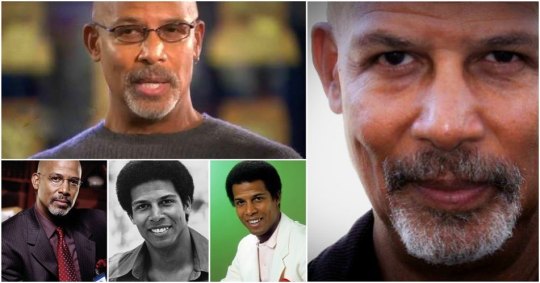
Lloyd Michael Warren (born March 5, 1946) is a retired television actor and former college basketball player, best known for playing Officer Bobby Hill on Hill Street Blues. He attended Central High School, whereas as a senior he was class president. He was twice named to the Indiana all-state team. He graduated as the Bears' career, season, and single-game scoring leader. He was inducted into the Indiana Basketball Hall of Fame. He played college basketball at UCLA, where he was a three-year varsity letterman and starting guard. Led by Lew Alcindor, the Bruins posted records of 30–0 in 1967 and 29–1 in 1968. Both teams captured the NCAA national championship. He was named to the NCAA All-Tournament team and was an All-American. The team is considered one of the best in college basketball history. He earned the award as the Bruins' best defender and he won the award as the Bruins' best "team player". He was inducted into the UCLA Athletics Hall of Fame. He played the role of park ranger P. J. Lewis on Sierra and went on to play a rookie officer in Adam-12. He starred as police officer Willie Miller in Paris. He guest-starred in In the House. He guest starred on Living Single as Khadijah's father and later portrayed Joan's father on Girlfriends. He played Darrin Dewitt Henson's boss on the show Soul Food, in which he played hustler-turned-entrepreneur Baron Marks. He had a recurring role on Lincoln Heights as Spencer Sutton, Eddie's father. He played Pete Bancroft in the Tales from the Darkside. He appeared as Virgil Tibbs' former longtime police partner. He was on the Early Edition episode Hoops. He played Wells in Sliders. He appeared in Buffy the Vampire Slayer, as a psychiatrist. His film work includes Norman... Is That You? and as basketball player Easley in Drive, He Said. He was in Fast Break as Preacher. He played Officer William Henderson in The District. He appeared in the independent film Anderson's Cross. #africanhistory365 #africanexcellence https://www.instagram.com/p/CpaGqmUrCeA/?igshid=NGJjMDIxMWI=
1 note
·
View note
Text
Guns N Roses is one of the greatest rock bands of all time. They hold the record for the best selling debut album of all time 'Appetite for Destruction' and are known for hit songs like 'Welcome to the Jungle', 'November Rain' etc.
So, how was the band formed?
Hollywood Rose Formation
Izzy Stradlin and Axl Rose knew each other for a long time. They were friends growing up and studied in the same school. Izzy first met Axl in the Jefferson high school in mid 70s. They both were from Lafayette in Indiana. Izzy knew he wanted to be a part of a rock band in future and felt that Axl could be the front man. The band Hollywood Rose was formed with Izzy, Axl and Chris Webber intially in 1983. Chris Webber had been introduced to Izzy at the parking lot of Rainbow bar and Grill by friend Tracii Guns earlier.
Road Crew Formation
Meanwhile the band Road Crew was formed by Slash, Steven Adler and Duff McCagan around the same time. Steven Adler was living in Hollywood and at Bancroft Junior High, he befriended Slash when Slash came to help him after a skate boarding accident. Slash and Adler became good friends after that. Adler went back to the San Fernando Valley where he stayed with his parents and learnt to play drums. He came back to Hollywood formed Road Crew with Slash. They were later joined by Duff McCagan who responded to their advertisement in the newspaper looking for a bassist. This was happening in 1983.
Road Crew was looking for a singer and carried out auditions, but were unable to find someone. They disbanded with no releases as they had no singer to fit their purpose.
Now, Hollywood Rose was doing live shows and they were joined by several other members like Rick Mars, Andre Troxx, etc. Johnny Kreis was the drummer for Hollywood Rose and he was the only consistent member along with Axl, Izzy and Chris.
Chris Webber and Johnny Kreis leave Hollywood Rose
In 1984, they were appearing for the show at Music Machine and during the show Chris accidently hit Axl with the headstock of his guitar. Axl was pretty annoyed and fired Chris eventually. Chris was replaced by Slash and Johnny Kreis was replaced by Steven Adler.
Slash first meeting with Axl and Izzy
Slash recalls meeting Axl and Izzy for the first time. He saw their advertisement in 'The Recycler' and decided to meet them with his friend Adler. They first went to the house and met at the back room. Slash recalls that nothing happened during that meeting. Slash saw Axl again at a barbeque joint called Harry's open pit barbeque in Sunset and Crescent Heights. Slash didn't speak to him but he recognized him. Later on, Steven Adler took Slash to a place called Gazzarri's to check out a group because supposedly they had a really good singer and the singer turned out to be Axl.
Hollywood Rose is disbanded and Axl joins L.A. Guns eventually forming Guns N Roses
Izzy was upset at the firing of Chris and left the group when Slash first came to rehearse with them. The group played a few more shows and eventually disbanded. Izzy was staying with Tracii Guns who was part of the band called L.A. Guns. They needed a new vocalist and Izzy suggested Axl to Tracii. Axl joined L.A. Guns as the vocalist and got into an argument with the band's manager who fired him. The same night Axl got fired, they decided to form a new band called Guns N Roses. Izzy was called to be a part of this band and he joined. Guns N Roses was initially the label they were going to release their music on and decided to keep it as their band name. The initial members were Axl, Izzy, Tracii, Gardener and Beich.
Their first show was promoted as ' LA Guns and Hollywood Rose present Guns N Roses' on March 26 1985. The drummer Beich was replaced by Duff McKagan after this show. Later on, Axl and Tracii got into an argument and Tracii was eventually replaced by Slash. Gardener quit soon after that and was replaced by Steven Adler. So, then eventually the lineup was formed which consisted of Izzy, Axl, Slash, Steven and Duff.
So that is how the band Guns N Roses was formed.
0 notes
Photo

Clips Bike Parking https://www.design-miss.com/clips-bike-parking/ Clips Bike Parking è un simpatico e creativo parcheggio per biciclette a forma di clip realizzato da Kaylyn & Kyle Bancroft. Via wildpigs.it
0 notes